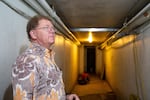Leslie Ricker and her family live in Gresham, home to the 12,000-student Gresham-Barlow School District, Oregon’s 10th largest.
When her oldest son, Sawyer, was in kindergarten in a Gresham-Barlow elementary school, Ricker says he was already getting bored with work that wasn’t challenging.
“He was finishing his worksheets early, and they were expecting him to find something to do,” said Ricker. “He wasn’t able to find something to do on his own.”
Ricker said the environment wasn’t working for her son, and she couldn’t afford private school. So she looked at Corbett, a small district at the eastern edge of Multnomah County.
Corbett is one-tenth the size of Gresham-Barlow. Its 1,200 students are spread across a preschool, middle school, high school, and a K-8 specializing in arts and Spanish.

Corbett is a small school district at the eastern edge of Multnomah County.
Elizabeth Miller / OPB
The small size and academic demands had a reputation among Ricker’s friends, and strangers alike.
“We would go to dinner at Olive Garden and people would say, ‘Oh, we’ve heard such great things about Corbett,’” Ricker described.
Half of Corbett’s students are like the Rickers, driving children to Corbett from as far away as Hood River, Portland or other parts of eastern Multnomah County.
The Rickers are happier.
“They do a lot of projects,” said Ricker. “They do a lot of stuff where they work as a team, where he can put in his effort.”
Corbett Works To Keep Out-Of-District Families
The legal mechanism that allows families like the Rickers to opt for Corbett rather than their local public school is expiring.
It's a little-known law called "open enrollment."
It may be felt most in Corbett, a district that has long relied on students who transfer in, and the money that comes with them.
School leaders in the small district are left with a dilemma: either downsize significantly, and lose teachers and programs, or find a way to continue to serve families from elsewhere.
Out-of-district students want to go to Corbett, and Superintendent Randy Trani says the district needs them.
“For us to survive, we’ve had to bring in out-of-district students and the money that follows them here,” said Trani.
The end of open enrollment could end that funding stream. So to avoid what some school leaders have called a “free fall” in funding, Trani plans to make Corbett a charter school district. That means Corbett’s schools would become charter schools and students could attend from anywhere.
“We just don’t have a choice,” said Trani. “Well, we do have a choice, but the choice isn’t what anybody would want for their school district.”
The alternative is a severe loss of teachers and funding, and a move to online courses, according to Trani.
The Corbett community appears to be mostly on board with the charter plan. And some see it as an opportunity for a deeper examination of what Corbett offers students from outside and inside the district boundaries.
Parents April and Eric Eaton grew up in Corbett and graduated from Corbett High. But their high school experience was very different from their daughter’s.
All of Corbett’s high school students are required to take at least six Advanced Placement (AP) classes by the time they graduate.
The Eatons say only in her last month of school has their daughter had time for more social events, like going over to a friend’s house.
Beyond academics, April Eaton wonders about what she calls the social and emotional costs of a rigorous AP curriculum.
“Our daughter’s up ‘til one or two in the morning on homework,” said Eric Eaton.
Parent and incoming school board member Cless Woodward puts it a different way.
“A school system should be a three-legged stool – you should have academics, extra-curricular, and maybe social,” said Woodward. “We’re academics, there’s no other leg to this stool at all.”
Woodward’s kids have graduated, and he says they are doing fine. And the Eatons’ daughter is off to attend college in Texas next year.
But when it comes to the Eatons’ eighth grade son, Corbett’s “AP for All” curriculum may not be right for him.
“If he’s feeling like he’s just barely making it in an AP class, then that’s not what I want him to be doing his time for four years,” said April Eaton. “We will choose to take him out and move him somewhere where he will thrive.”
The Eatons wonder how many in-district students have left Corbett, but Superintendent Trani says only about 20 students have transferred away through open enrollment.

Eric and April Eaton have two children attending Corbett Schools, and they both grew up in Corbett.
Elizabeth Miller / OPB
Eric Eaton concludes that Corbett’s schools aren’t truly serving the Corbett community.
“In my opinion, a rural school like we are should represent a rural economy and what the people do around here,” said Eaton. “We farm; we’re inventors; we’re contractors like me.”
Like other community members, the Eatons distrust the school district decision-makers. They acknowledge that moving to the charter is probably necessary, but they're wary of the freedom that it could give district leadership. The school charter could set policies like class size limits and who is on the school board.
Trani says virtually nothing will change if Corbett moves to a charter. He says the elected Corbett school board would remain in charge.
But a community divide years in the making remains between those who trust school leaders and those who don’t.
And those fractured relationships have consequences as clear as a proverbial crack in a school foundation.
A Crumbling Middle School With Failed Bond After Failed Bond
Trani says the Corbett Middle School building is made of unreinforced masonry, a fragile building material that has drawn criticism for its seismic vulnerability.
“It’s basically flowerpot material that’s hollow inside and then they glue those bricks together,” said Trani.
He points out Americans with Disabilities Act violations, asbestos in the basement, and lead paint "almost everywhere."
Students are still in the building, but safety concerns prevent them from using parts of it. They’ve even modified the building’s fire drills.
“Our drill is different than any other building on campus,” explained Vice Principal Kathy Childress. “Ours is, ‘Get out of the building as fast as you can.’”
When Trani started as superintendent eight years ago, he knew the building was in bad shape.
“But it wasn’t until I brought the first architects out that we realized just how dangerous the building was from an earthquake standpoint,” said Trani.

Corbett Superintendent Randy Trani walks through an uninhabited part of Corbett Middle School – which he says is desperately in need of repairs.
Elizabeth Miller / OPB
Student safety is one reason the district is combining eighth and ninth grades for next year, moving eighth graders into the high school.
A more permanent situation will cost some money. But in order to get that money, the district needs local support for a bond.
The Eatons are like a majority of Corbett voters who have made a habit out of voting against school bonds.
“This is our fourth time we’ve voted 'no' on a bond,” said Eric Eaton. “We always want to vote 'yes' – and we’re not the minority out here.”
With every election, the bond gets closer to passing. And there is a belief held by some in the community that if the district puts another bond on the ballot, it will pass.
But Eric Eaton wants to see a bond with more widespread support.
“It’s always about 'One more vote just to inch it past the goal line.' To me, that’s a loss,” said Eaton. “When you have a divided community and your goal is to win by one vote on a school, that’s horrible.”
Fellow Corbett resident and ‘no’ voter Travis Younker agrees.
“You can throw it at us as much as you want, but as long as silent majority keeps voting 'no,' then it’s not going to happen,” said Younker.
Corbett is far from the only community dealing with failed school bonds. In a district, sometimes a ‘no’ vote is the only way to show dissatisfaction with a leader’s decisions.
Between the failed bonds and fractured trust with the community, and the looming transition from open enrollment to a charter district, a community group asked for outside help.
Saxton Report Brings A ‘Sigh of Relief’
Rob Saxton has had many titles and jobs in school leadership, including three years as the head of the Oregon Department of Education.
Now he’s consulting. His first gig was a survey of the Corbett community and its relationship with the school district.
“I've seen a lot of controversy in communities over a variety of different things in relationship to schools, but nothing quite like this,” said Saxton. “This is broad and pervasive amongst the community and kids.”
Saxton intended to spend 50 hours on the work. By now, he says it’s been more like 250 hours.
The Corbett School District didn't hire Saxton. A group of five community members brought him in. They call themselves IC3S — Independent Citizens for Sustainable Schools — and their goal is to repair the community's relationship to the school.
“We’re trying to do everything we can to keep bringing the community and the district together,” said group member Cless Woodward.

Independent Citizens for Sustainable Schools is made up of a small group of Corbett community members. Their goal is to repair the community’s relationship to the school.
Elizabeth Miller / OPB
To do that, they needed some answers to longstanding questions. And because of trust issues, they looked for an outside source to do the work.
Saxton sought to answer three main questions: how to solve Corbett’s problem with open enrollment ending, whether the school’s programming is right for the student population, and recommendations to increase community support for the school.
He found that the district is well-managed financially, but folks want more career tech classes. And there are three camps when it comes to community opinion of the school.
“About a third of the community is very supportive of what the district does, about a third of the community is not at all supportive of what they're doing,” said Saxton. “And then there's another third that says, ‘Well, there's parts of this we like, and then there's other parts of it that we don't like at all.’”
Saxton interviewed community members, staff and students and discovered a strong affinity for the school and its teachers. But there was also a hunger for change.
Students said they wanted more elective options and said classrooms were focused more on passing AP classes than on learning. Community members mentioned a lack of transparency from the district and a concern for the school’s lack of success in athletics. Staff worried about funding and the impact of negative social media posts from community members.
Saxton’s recommendations include moving to a charter school for the 2020-2021 school year and offering more career tech courses.
He also recommends the school shrink — but only a little so it can remain financially sustainable and offer a variety of classes.
"Anything between 800 and 1,050 students seems reasonable to me," reads the report. That would be a drop of between 150 and 400 students.
One of Saxton’s biggest recommendations for Corbett is about trust. He suggested the school district form a covenant with the community.
“They have a broken trust delivery relationship in the community,” said Saxton.
That lack of trust has resulted in four failed bonds. But there are signs, in spite of buildings that are falling apart and a critical law expiring, that the Corbett community feels the district may be turning things around.
The Eatons say if the district implements the recommendations in the Saxton report, they would be more inclined to vote 'yes' on the next bond.
And the Saxton report presents a scenario where Corbett could continue without open enrollment.
IC3S member and parent Jeff Aho said community members have walked up to him at the Corbett market to express their optimism.
“Maybe there’s a way to move forward without fighting,’” Aho remembered hearing.
But he says community support for a smaller school doesn’t mean they won’t want any out-of-district students.
“We want to be welcoming to families that want to come out here, but they have to realize that this is this community’s school,” said Aho, a former Corbett school board member. “We want to share an education with them, but we don’t want to relinquish control of our community school.”
Using Saxton’s numbers, Corbett would still rely on hundreds of out-of-district students, and would be the largest charter district in Oregon. Pursuing a charter district could help the district financially by maintaining its enrollment. The step may not alienate many people in Corbett, but charters have long been controversial in Oregon, particularly with the state’s powerful teachers’ union.
Other Oregon Districts Have Gone Charter – But Not Like This
Twenty Oregon school districts have made the move to a charter, but Corbett would be the biggest in the state — and the closest to the state's urban center and so many other districts.
With the move to a charter, Corbett could keep taking students from those other districts. Oregon Education Association president John Larson says the schools those students leave behind would suffer.
OEA testified against open enrollment and says it does not "support the expansion of charter schools at the expense of traditional neighborhood public schools."
“Because of the way that we fund schools in Oregon, one school's advantage is the other school’s disadvantage,” said Larson. “Often those tend to be parents of means that are able to transport their students to that charter school.”
Larson says that deepens the socioeconomic divide between districts.

All Corbett students are encouraged to apply to college as part of a rigorous academic program.
Elizabeth Miller / OPB
Corbett shouldn't have to worry about increasing enrollment to stay open, argues Larson. He points to recent passage of House Bill 3427, often called the Student Success Act, which promises to deliver a $1 billion per year more to Oregon schools.
But Corbett Superintendent Trani says that money wouldn’t be enough.
OEA is also skeptical of charter schools because they can employ teachers who aren’t licensed union members.
A Community ‘Covenant’
The Corbett community has shown that it wants to be involved, some would say very involved, in how its schools are run.
Community members come to school board meetings armed with binders of research and data. They calculate how much money the bond should ask for, or how many square feet a new school would need to be. And they stay late after the meetings to share their numbers with the board and superintendent.
Following Saxton’s recommendation for a "covenant," the district formed a committee of community members, out-of-district parents, and staff, in order to build trust.
Fifty people applied for 10 non-staff spots on the committee.
But some felt even that process lacked transparency.
And Corbett residents who attended last month's school board meeting were surprised to see a resolution to approve a charter application for the district on the agenda. It struck some as moving too quickly on a complicated change.
“We would like to express our concern that this decision perpetuates a pattern of rushed and ill-informed decision-making that negatively impacts the relations with our community at large,” said IC3S member Mikaila Way during public comment at the meeting.
The board agreed to postpone the vote in order to have more time to evaluate the proposal and get input from the community.
Meantime, the challenges facing Corbett can’t be put off forever. The district plans to use only a portion of Corbett Middle School for the indefinite future, due to its safety problems.
And dozens of out-of-district families have expressed interest in attending Corbett next year.
Superintendent Trani says he’s already heard from the families of at least 100 students hoping to put their kids in Corbett schools. He’s told them to sit tight — the school board may vote to start the charter process at its June 19 meeting.
No matter what happens, IC3S members would like to see the district make a better effort to be transparent in its plans.
“You’re working from a deficit right now, and you are in a position where you have to rebuild a relationship that’s been strained for a long time,” said Way.
Editor’s Note: A previous version of this story misstated who hired Rob Saxton. The Corbett School District hired him, but his contract was managed by the community group Independent Citizens for Sustainable School Solutions.